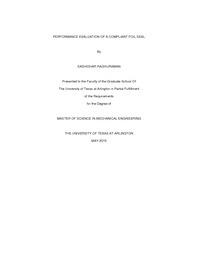
ATTENTION: The works hosted here are being migrated to a new repository that will consolidate resources, improve discoverability, and better show UTA's research impact on the global community. We will update authors as the migration progresses. Please see MavMatrix for more information.
Show simple item record
| dc.contributor.author | Raghuraman, Sashidhar | en_US |
| dc.date.accessioned | 2015-07-31T22:10:18Z | |
| dc.date.available | 2015-07-31T22:10:18Z | |
| dc.date.submitted | January 2015 | en_US |
| dc.identifier.other | DISS-13167 | en_US |
| dc.identifier.uri | http://hdl.handle.net/10106/25107 | |
| dc.description.abstract | The concept of foil bearings has gained large acceptance in the industry and is been applied for various rotating equipment including air cycle machines, cryogenic turbo-expanders, centrifugal compressors and gas turbine engines. The ever-increasing demand for maintenance free and durable components has led to the development of compliant foil seals (CFS). Labyrinth and Brush seals have been widely employed for reducing the leakage flow at high pressure and temperature conditions, to enhance the overall performance of the system. Increase in the radial clearance to compensate the lack of their capability to accommodate the higher rotor orbits results in more leakage. By overcoming these limitations, the foil seal has immensely drawn the attention. Methods are being researched to make CFS much more reliable and durable for wide applications. The operating principle of this non-contacting foil seal is based on the foil bearing technology. Using air as the fluid, the foil seal builds hydrodynamic pressure, which not only solves the purpose of sealing the leakage, also exhibits the bearing properties. This work presents the design, fabrication and assembly of a foil seal, its investigation at various conditions and solution to few dynamics problems faced during experimentation. A previously constructed test rig was utilized to test the newly fabricated foil seal. Prior to the preliminary test, the radial clearance value of the foil seal was obtained using a push-pull mechanism. Two ball bearings were used in the test rig to ensure reduced damping for accuracy in evaluation of foil seal. The rotor displacements were measured before testing the foil seal. Preliminary tests indicated issues including higher friction during deceleration and no sealing action. The seal was redesigned and fabricated in Single pad and Three-pad configurations to resolve these issues. The sealing capacity was recorded at rotor speeds and the differential pressure achieved across the seal was noted. Simultaneously, the frictional force values were also monitored. The inclusion of three-pad design was done to evaluate the performance for a continuous and stable operation, which was restricted in one pad foil seal. The test results for all the configurations are discussed and improvement in current fabrication methods are being proposed. | en_US |
| dc.description.sponsorship | Kim, Daejong | en_US |
| dc.language.iso | en | en_US |
| dc.publisher | Mechanical Engineering | en_US |
| dc.title | Performance Evaluation Of Compliant Foil Seal | en_US |
| dc.type | M.Engr. | en_US |
| dc.contributor.committeeChair | Kim, Daejong | en_US |
| dc.degree.department | Mechanical Engineering | en_US |
| dc.degree.discipline | Mechanical Engineering | en_US |
| dc.degree.grantor | University of Texas at Arlington | en_US |
| dc.degree.level | masters | en_US |
| dc.degree.name | M.Engr. | en_US |
Files in this item
- Name:
- Raghuraman_uta_2502M_13167.pdf
- Size:
- 2.202Mb
- Format:
- PDF
This item appears in the following Collection(s)
Show simple item record


